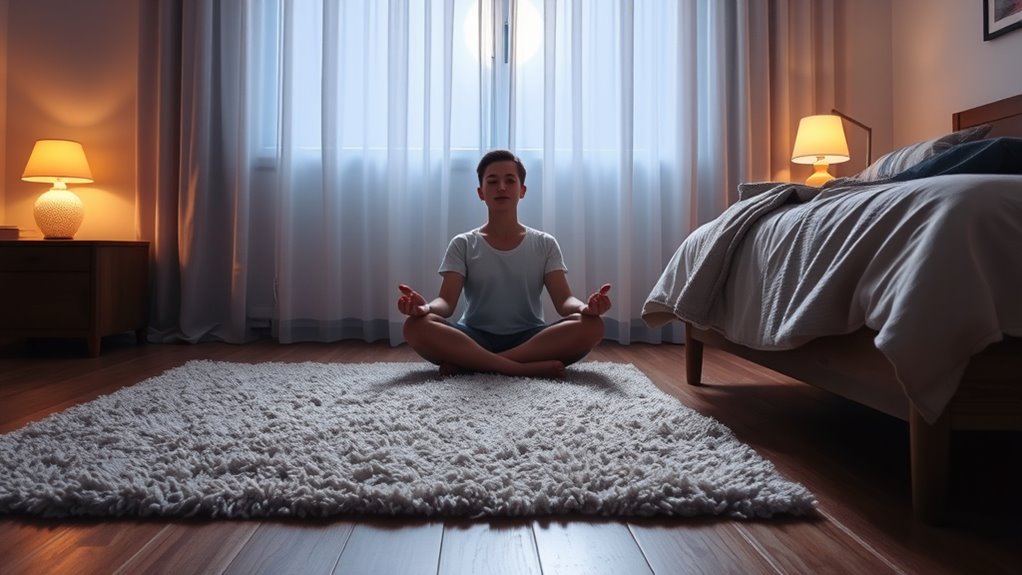When waking up anxious or restless, grounding exercises can help you relax and return to sleep. Focus on your breathing by taking slow, deep breaths—inhale through your nose, hold, then exhale fully. Use your senses: notice the sounds around you, touch nearby objects, or identify colors and textures. Smell calming scents or pay attention to bodily sensations. These techniques restore calm and keep you present, making it easier to drift back into restful sleep if you explore more.
Key Takeaways
- Practice slow, deep breathing with a 4-4-6 count to calm the nervous system during night wakings.
- Use sensory awareness by focusing on chest movement, air flow, or belly sensations to anchor in the present moment.
- Identify and describe five room objects’ colors, textures, or shapes to enhance mindfulness and reduce anxiety.
- Engage with subtle sounds, tactile sensations, or taste to promote calmness and distract from racing thoughts.
- Incorporate scents like lavender or lotion to create calming associations and deepen relaxation for easier sleep return.

When you wake up in the middle of the night feeling anxious or restless, grounding exercises can help you regain calm and ease back into sleep. One effective approach involves focusing on your breathing and developing sensory awareness. Start by taking slow, deep breaths, inhaling through your nose for a count of four, holding that breath for a count of four, then exhaling slowly through your mouth for a count of six. This breathing technique calms your nervous system and reduces racing thoughts. As you breathe, pay close attention to how your body feels—notice the rise and fall of your chest, the air entering and leaving your nostrils, and the sensation of your belly expanding and contracting. This sensory awareness anchors you to the present moment, preventing your mind from spiraling into worry or overthinking. Engaging your senses is a powerful way to ground yourself during night wakings. Focus on what you can see, hear, touch, taste, and smell. For example, look around your room and identify five objects, describing their colors, shapes, or textures in your mind. Notice the texture of your sheets, the coolness of the pillow, or the soft glow of a nightlight. You might also listen for subtle sounds—like distant traffic, the hum of your refrigerator, or the rustling of the sheets. Touch something nearby, such as the fabric of your pajamas or the smooth surface of a bedside table, and feel its temperature and texture. If you’re able, take a gentle sip of water or notice the taste lingering in your mouth. Smelling a familiar scent, like lavender or a favorite lotion, can further ground you and create a calming association. Incorporating mindfulness techniques can deepen your relaxation and help you reconnect with the present moment.
Frequently Asked Questions
Can Grounding Exercises Replace Medical Treatment for Sleep Issues?
Grounding exercises can’t replace medical treatment for sleep issues, but they can be a helpful complementary therapy. If you struggle with sleep, focusing on good sleep hygiene—like maintaining a consistent bedtime and limiting screen time—along with grounding techniques, may improve your rest. Always consult a healthcare professional for persistent sleep problems, as grounding exercises alone aren’t a substitute for medical advice or treatment.
Are Grounding Exercises Suitable for Children During Night Wakings?
You’ll be glad to know that child-friendly grounding techniques can be effective during night wakings, especially since studies show 60% of parents find simple routines helpful. These exercises are gentle, safe, and easy to incorporate into your child’s nighttime routines, making them suitable for children. They help your little one feel secure and calm, encouraging self-soothing and better sleep without relying solely on medical treatments.
How Long Should a Grounding Exercise Session Last During Night Awakenings?
You should aim for grounding exercises during night awakenings to last about 1 to 3 minutes, following general duration guidelines. Keep the sessions short and focused to help your child settle back to sleep quickly. Incorporate exercise frequency by doing these exercises at each waking, but avoid overdoing it. Consistency is key, so develop a routine that balances effective calming with enough rest for both of you.
Can Grounding Techniques Help With Nightmares or Night Terrors?
Research shows that around 50% of children experience night terrors, and grounding techniques can substantially help. Yes, grounding techniques can aid in night terror management and provide nightmare relief. When you practice these methods, like focusing on your senses or breathing, you may reduce fear and anxiety. Incorporate them into your nightly routine to help manage distressing dreams and improve sleep quality, giving you a better night’s rest.
Are There Any Risks or Side Effects Associated With Grounding Exercises at Night?
There are minimal risks involved with grounding exercises at night, but some side effects could include feeling more alert or anxious if the exercises become too stimulating. If you have underlying health issues or anxiety, these techniques might temporarily increase discomfort. It’s best to start slowly and pay attention to how your body responds. If you experience ongoing discomfort or side effects, consider consulting a healthcare professional for personalized advice.
Conclusion
Next time you wake in the dark, try grounding exercises—you might just feel the cool floor beneath your feet or the steady rhythm of your breath. These simple actions can anchor you back to the present, turning restless nights into moments of calm. But beware—once you discover this secret, you may never look at night wakings the same way again. Are you ready to unleash your mind’s hidden strength and reclaim peaceful sleep?










